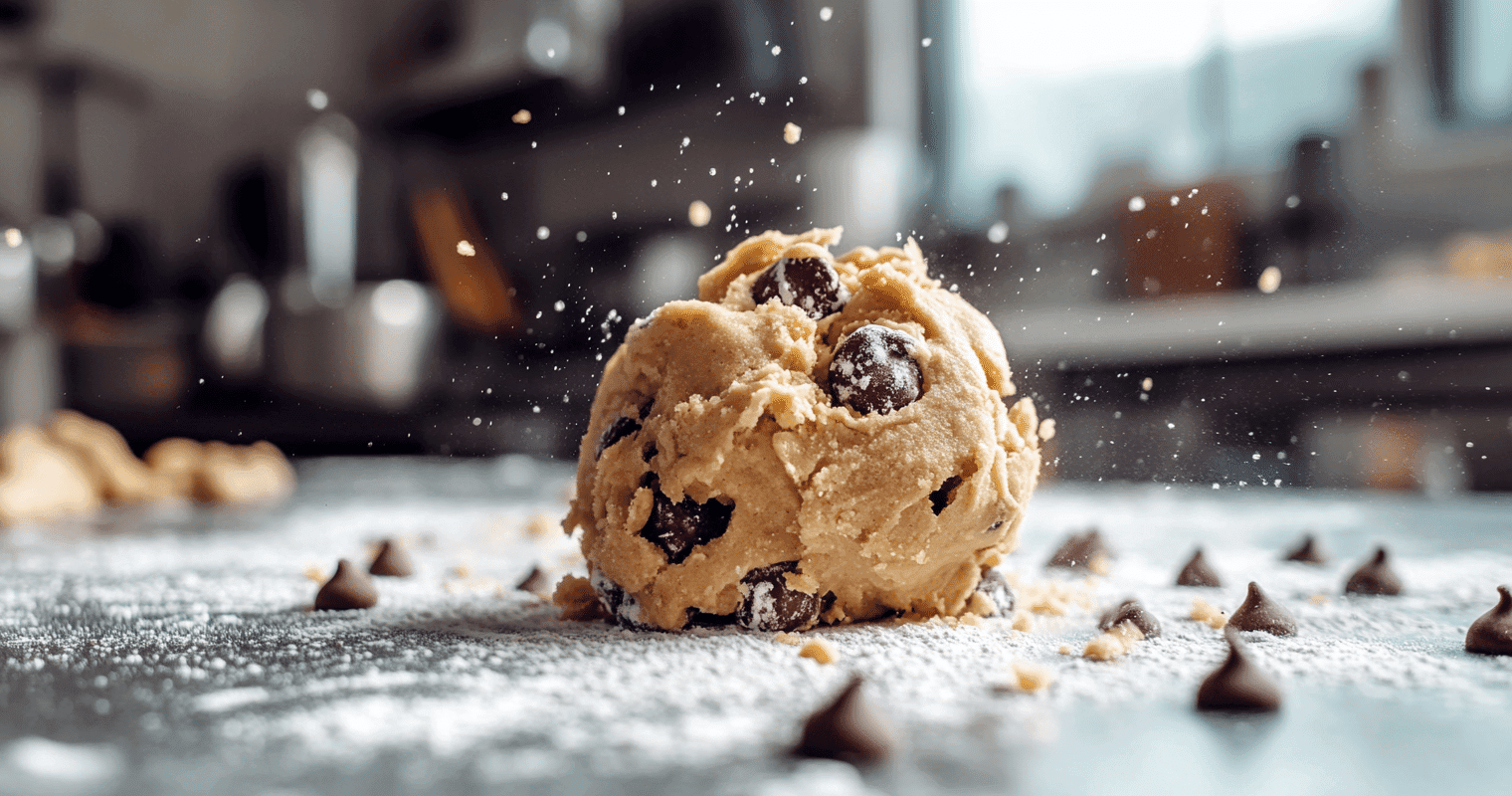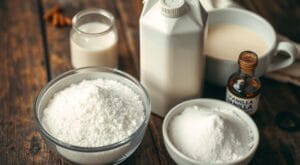Jump to:
Estimated reading time: 16 minutes
Table of contents
Introduction
Baking is both a science and an art, where even slight deviations from a recipe can lead to unexpected results. One common issue that bakers face is when their cookie dough turns out more like cake batter. This can be frustrating, especially if you’re aiming for thick, chewy cookies but end up with dough that’s too runny or fluffy. Understanding why your cookie dough is like batter is the first step in fixing the problem and ensuring your cookies turn out just right.
In this article, we’ll explore the reasons why your cookie dough like batter issue occurs, the science behind it, and practical solutions to bring your dough back to the ideal consistency. Whether you’re a seasoned baker or a beginner, these insights will help you troubleshoot and perfect your cookie dough every time.
Understanding the Difference: Cookie Dough vs. Cake Batter
Before diving into the causes of cookie dough like batter, it’s important to understand the fundamental differences between cookie dough and cake batter. While both are mixtures of similar ingredients, their ratios and consistency are designed to produce very different outcomes, this thread on reddit offers insightful details.
Cookie Dough Characteristics
Cookie dough is typically thick, dense, and pliable. It’s designed to hold its shape when scooped or rolled, which is why cookies often maintain their form during baking. The dough is usually rich in fats, such as butter or shortening, which contribute to a tender, chewy texture. The flour-to-liquid ratio is higher in cookie dough, which results in a stiffer consistency.
Cake Batter Characteristics
Cake batter, on the other hand, is much thinner and more fluid. It’s designed to be poured or spread into a baking pan, where it will rise and expand during baking. Cake batter contains more liquid ingredients, such as milk or water, which helps create a light, airy texture in the final product. The leavening agents in cake batter, like baking powder or baking soda, are also present in higher quantities, contributing to the rise and fluffiness.
When your cookie dough like batter issue arises, it’s often because the dough has taken on characteristics more akin to cake batter. This could be due to several factors, which we’ll explore in the next sections.
Common Causes of Cookie Dough Like Batter
Several factors can cause your cookie dough like batter problem, ranging from ingredient ratios to mixing techniques. Understanding these causes can help you identify what went wrong and how to correct it.
1. Too Much Liquid
One of the most common reasons for cookie dough like batter is an excess of liquid ingredients. Whether it’s too much milk, eggs, or even liquid flavorings like vanilla extract, an imbalance in the liquid-to-dry ingredient ratio can lead to a dough that is too runny.
How It Happens:
- Over-measuring Liquid Ingredients: Accidentally adding too much milk or eggs can turn your cookie dough into something closer to cake batter.
- High-Humidity Environments: In humid climates, flour can absorb moisture from the air, leading to a wetter dough than intended.
Solution:
- Adjust the Liquid: If you suspect that too much liquid is the cause, try reducing the amount of milk, eggs, or other liquids in the recipe. Alternatively, you can add more flour to balance out the moisture.
2. Insufficient Flour
Flour is the structural backbone of cookie dough, and too little flour can result in a dough that behaves more like cake batter. The flour helps to thicken the dough and give it the necessary stability to hold its shape during baking.
How It Happens:
- Under-measuring Flour: Not measuring flour accurately, especially if you’re using a method like scooping directly from the bag, can result in less flour than needed.
- Incorrect Flour Type: Using a flour with lower protein content, such as cake flour instead of all-purpose flour, can also lead to a softer dough.
Solution:
- Add More Flour: Gradually add more flour to the dough until it reaches the desired consistency. Be sure to mix the dough gently to avoid overworking the gluten, which can make the cookies tough.
3. Overmixing the Dough
Overmixing is another common culprit behind cookie dough like batter. When dough is overmixed, the gluten in the flour becomes overdeveloped, leading to a dough that is more elastic and less firm. This can cause the dough to spread more during baking, resulting in cookies that are thin and cake-like.
How It Happens:
- Using a Mixer on High Speed: Mixing the dough at high speed for too long can overwork the gluten.
- Incorporating Air: Overmixing can also incorporate too much air into the dough, making it lighter and more similar to cake batter.
Solution:
- Mix Gently: Mix the dough just until the ingredients are combined. If using a stand mixer, mix on low speed and stop as soon as the flour is fully incorporated.
4. Too Much Leavening Agent
Leavening agents like baking soda or baking powder are responsible for the rise and fluffiness in baked goods. However, too much leavening can cause your cookie dough like batter problem by making the dough too light and airy.
How It Happens:
- Misreading the Recipe: Adding too much baking soda or baking powder by mistake can lead to excessive rise and a cake-like texture.
- Double-acting Baking Powder: If your recipe calls for regular baking powder and you use double-acting instead, you may end up with more rise than intended.
Solution:
- Check the Leavening Amount: Double-check the recipe and measure leavening agents carefully. If you suspect too much leavening is the issue, you may need to start over with a new batch of dough.
5. Using Melted Butter
Butter is a key ingredient in cookie dough, contributing to both flavor and texture. However, using melted butter instead of softened butter can cause the dough to become too runny, leading to a cookie dough like batter consistency.
How It Happens:
- Melted Butter: If the butter is melted rather than softened, it introduces more liquid into the dough, resulting in a batter-like consistency.
- Warm Kitchen Environment: In a warm kitchen, even softened butter can become too soft, leading to issues with the dough’s texture.
Solution:
- Use Softened Butter: Use butter that is soft but still holds its shape. If the butter has melted, consider chilling it slightly before adding it to the dough.
6. Not Chilling the Dough
Chilling the dough is a crucial step in many cookie recipes, as it helps to solidify the fats and thicken the dough. Skipping this step can result in dough that is too soft and more like cake batter.
How It Happens:
- Skipping the Chill Time: If you’re in a hurry and skip the chilling step, the dough may be too warm and soft.
- Inadequate Chilling: Chilling the dough for too short a time can also result in a dough that is still too soft to work with.
Solution:
- Chill the Dough: After mixing the dough, refrigerate it for at least 30 minutes to an hour before baking. This helps to firm up the dough and prevents excessive spreading.
By identifying these common causes, you can better understand why your cookie dough like batter issue has occurred. Next, we’ll explore practical solutions to fix your dough and get it back to the right consistency.
How to Fix Cookie Dough Like Batter
If you’ve found that your cookie dough like batter is too runny or soft, don’t worry—there are several ways to fix it and get your dough back on track. Here’s how you can salvage your dough and ensure your cookies turn out perfectly.
1. Add More Flour
As mentioned earlier, adding more flour is one of the most effective ways to fix cookie dough like batter. Flour helps to thicken the dough and provide the structure needed for the cookies to hold their shape during baking.
How to Do It:
- Start by adding 1-2 tablespoons of flour at a time, gently folding it into the dough.
- Continue adding flour until the dough reaches the desired consistency. It should be thick enough to hold its shape when scooped or rolled.
- Be careful not to add too much flour at once, as this can make the cookies dry and tough.
2. Chill the Dough
Chilling the dough is another effective way to firm it up if it’s too soft or runny. This method works particularly well if the dough has been overmixed or if the butter was too warm when added.
How to Do It:
- Place the dough in a covered bowl or wrap it in plastic wrap.
- Refrigerate the dough for at least 30 minutes to an hour. If the dough is still too soft after chilling, you can leave it in the refrigerator for longer.
- If you’re in a hurry, consider dividing the dough into smaller portions before chilling, as this will help it firm up faster.
3. Add a Thickening Agent
In addition to flour, you can also add other thickening agents to help firm up cookie dough like batter. Cornstarch, cocoa powder, or even ground oats can be used to absorb excess moisture and thicken the dough.
How to Do It:
- Add 1-2 tablespoons of cornstarch, cocoa powder, or ground oats to the dough.
- Gently mix the thickening agent into the dough until it reaches the desired consistency.
- Sift any dry ingredients before adding them to the dough to avoid lumps.
4. Use Cold Ingredients
Using cold ingredients, particularly butter, can help prevent cookie dough like batter from becoming too runny. Cold butter is less likely to melt during mixing, which helps maintain the dough’s structure.
How to Do It:
- Use butter that is cold and cubed, rather than fully softened or melted.
- If the dough is already mixed and too soft, try incorporating small cubes of cold butter into the dough to firm it up.
- Consider chilling other ingredients, such as eggs, before adding them to the dough.
5. Reduce Liquid Ingredients
If you suspect that too much liquid is the cause of your cookie dough like batter issue, consider reducing the amount of liquid ingredients in the recipe. This includes eggs, milk, or any liquid flavorings.
How to Do It:
- Start by reducing the amount of milk or eggs by 25%.
- If the dough is still too soft, you can reduce the liquids further, but be cautious not to make the dough too dry.
- If you’ve already added too much liquid, balance it out by adding more flour or another thickening agent.
6. Incorporate Mix-Ins
Adding mix-ins, such as chocolate chips, nuts, or dried fruit, can help to firm up cookie dough like batter. These ingredients add bulk to the dough, making it thicker and easier to work with.
How to Do It:
- Gently fold in your choice of mix-ins, such as chocolate chips, chopped nuts, or dried fruit.
- Be sure not to overmix the dough when adding the mix-ins, as this can lead to a tough texture.
- If the dough is still too soft after adding mix-ins, consider chilling it for 15-30 minutes before baking.
7. Bake a Test Cookie
If you’ve made adjustments to your cookie dough like batter and are unsure if it’s ready, try baking a test cookie. This will give you a sense of how the dough will behave in the oven and whether further adjustments are needed.
How to Do It:
- Scoop a small portion of dough onto a baking sheet and bake it at the recommended temperature.
- Observe how the cookie spreads and check its texture once baked.
- If the test cookie spreads too much or is too soft, consider adding more flour or chilling the dough further before baking the rest of the batch.
By following these steps, you can fix your cookie dough like batter and get it back to the right consistency for baking. Next, we’ll discuss how to prevent this issue from occurring in the first place.
How to Prevent Cookie Dough Like Batter in the Future
While it’s possible to fix cookie dough like batter, it’s always better to prevent the issue from happening in the first place. Here are some tips and best practices to help you achieve the perfect cookie dough consistency every time.
1. Measure Ingredients Accurately
Accurate measurement of ingredients is crucial for achieving the right dough consistency. This includes both dry and liquid ingredients, as even small variations can impact the texture of the dough.
How to Do It:
- Use a kitchen scale to measure ingredients by weight, which is more accurate than measuring by volume.
- When measuring flour, use the spoon-and-level method rather than scooping directly from the bag. This helps to avoid compacting the flour, which can lead to too little flour in the dough.
- Measure liquid ingredients in a liquid measuring cup at eye level to ensure accuracy.
2. Use the Right Type of Flour
Using the correct type of flour is important for achieving the desired dough consistency. Different flours have different protein contents, which can affect the texture of the dough.
How to Do It:
- Use all-purpose flour for most cookie recipes, as it provides the right balance of structure and tenderness.
- Avoid using cake flour or pastry flour unless specified in the recipe, as these flours have lower protein content and can result in a softer, more cake-like dough.
- If you’re using a gluten-free flour blend, make sure it’s designed for baking and contains a mix of flours and starches to mimic the properties of wheat flour.
3. Control the Temperature of Ingredients
The temperature of your ingredients, particularly butter and eggs, plays a significant role in the consistency of the dough. Using ingredients at the correct temperature can help prevent cookie dough like batter issues.
How to Do It:
- Use softened butter that is cool to the touch but still holds its shape. If the butter is too warm, it can make the dough too soft.
- Bring eggs to room temperature before mixing them into the dough. Cold eggs can cause the butter to harden and lead to an uneven dough texture.
- If you’re baking in a warm kitchen, consider chilling the dough after mixing to prevent it from becoming too soft.
4. Mix Dough Gently
Overmixing is a common cause of cookie dough like batter, as it can incorporate too much air and develop the gluten in the flour. Mixing the dough gently helps to maintain the right consistency.
How to Do It:
- Mix the dough just until the ingredients are combined. Avoid overmixing, especially once the flour has been added.
- If using a stand mixer, mix on low speed and stop as soon as the dough comes together.
- Fold in mix-ins by hand to avoid overworking the dough.
5. Chill the Dough When Needed
Chilling the dough is a key step in many cookie recipes, as it helps to firm up the dough and prevent excessive spreading during baking.
How to Do It:
- After mixing the dough, refrigerate it for at least 30 minutes to an hour before baking.
- If the dough is still too soft after chilling, you can leave it in the refrigerator for longer or even freeze it briefly.
- For cut-out cookies, chill the dough both before and after cutting the shapes to ensure clean edges and minimal spreading.
6. Follow the Recipe Carefully
Following the recipe closely is essential for achieving the right dough consistency. Pay attention to ingredient quantities, mixing times, and temperature instructions.
How to Do It:
- Read through the entire recipe before starting to ensure you understand each step.
- Follow the recipe’s instructions for ingredient temperatures, mixing times, and chilling times.
- If you’re making adjustments to the recipe, such as reducing sugar or adding mix-ins, consider how these changes might affect the dough’s consistency.
By following these tips, you can prevent your cookie dough like batter issue from occurring in the future and enjoy perfectly baked cookies every time.
Common Questions About Cookie Dough Like Batter
Even with detailed instructions and tips, you may still have questions about how to handle cookie dough like batter. Here are some common questions and answers to help you troubleshoot and perfect your dough.
Why is my cookie dough too runny?
Your cookie dough may be too runny due to excess liquid ingredients, insufficient flour, or overmixing. To fix it, try adding more flour or chilling the dough to firm it up.
Can I fix cookie dough that is too much like cake batter?
Yes, you can fix cookie dough like batter by adding more flour, chilling the dough, or incorporating thickening agents like cornstarch or cocoa powder.
How do I know if my cookie dough is too soft?
Cookie dough is too soft if it spreads excessively when scooped or rolled, or if it lacks the structure to hold its shape. It should be thick and pliable, not runny or batter-like.
What happens if I bake dough that is too soft?
Baking dough that is too soft can result in cookies that spread too much, are thin and crispy, or have an uneven texture. The cookies may also bake unevenly, with edges that are overdone and centers that are undercooked.
Can I use melted butter in cookie dough?
It’s best to use softened, but not melted, butter in cookie dough. Melted butter can make the dough too runny and result in a cookie dough like batter consistency. If your butter has melted, consider chilling it slightly before adding it to the dough.
How can I avoid overmixing cookie dough?
To avoid overmixing, mix the dough just until the ingredients are combined. Use low speed on a stand mixer and stop as soon as the flour is fully incorporated. Fold in mix-ins by hand to prevent overworking the dough.
Is it necessary to chill cookie dough?
Chilling cookie dough is often necessary to firm it up, prevent excessive spreading during baking, and enhance the flavors. Skipping this step can result in dough that is too soft and cookies that don’t hold their shape.
How much flour should I add to fix runny dough?
Start by adding 1-2 tablespoons of flour at a time, gently folding it into the dough until it reaches the desired consistency. Be careful not to add too much flour at once, as this can make the cookies dry and tough.
By addressing these common questions, you can better understand how to handle and fix cookie dough like batter, ensuring that your cookies turn out perfectly every time.
Conclusion: Cookie Dough Like Batter
Baking cookies is a rewarding experience, but it can be frustrating when your dough doesn’t turn out as expected. If you’ve encountered the issue of cookie dough like batter, it’s important to understand the causes and solutions to fix it. Whether it’s due to too much liquid, insufficient flour, or overmixing, there are several ways to bring your dough back to the right consistency.
By following the tips and techniques outlined in this article, you can troubleshoot and correct cookie dough like batter problems, ensuring that your cookies are thick, chewy, and delicious. From adding more flour to chilling the dough, these solutions will help you achieve the perfect cookie dough every time.
Remember, baking is both a science and an art, and even experienced bakers encounter challenges. The key is to learn from each experience, refine your techniques, and enjoy the process of creating delicious treats. So the next time you find your cookie dough like batter, you’ll know exactly what to do to fix it and bake cookies that everyone will love. Happy baking!






